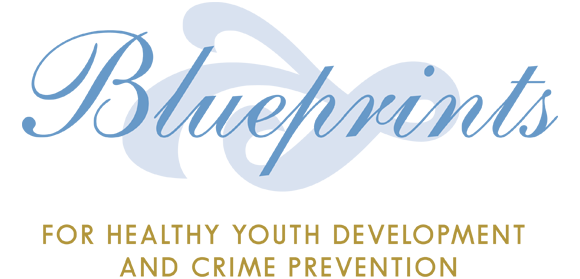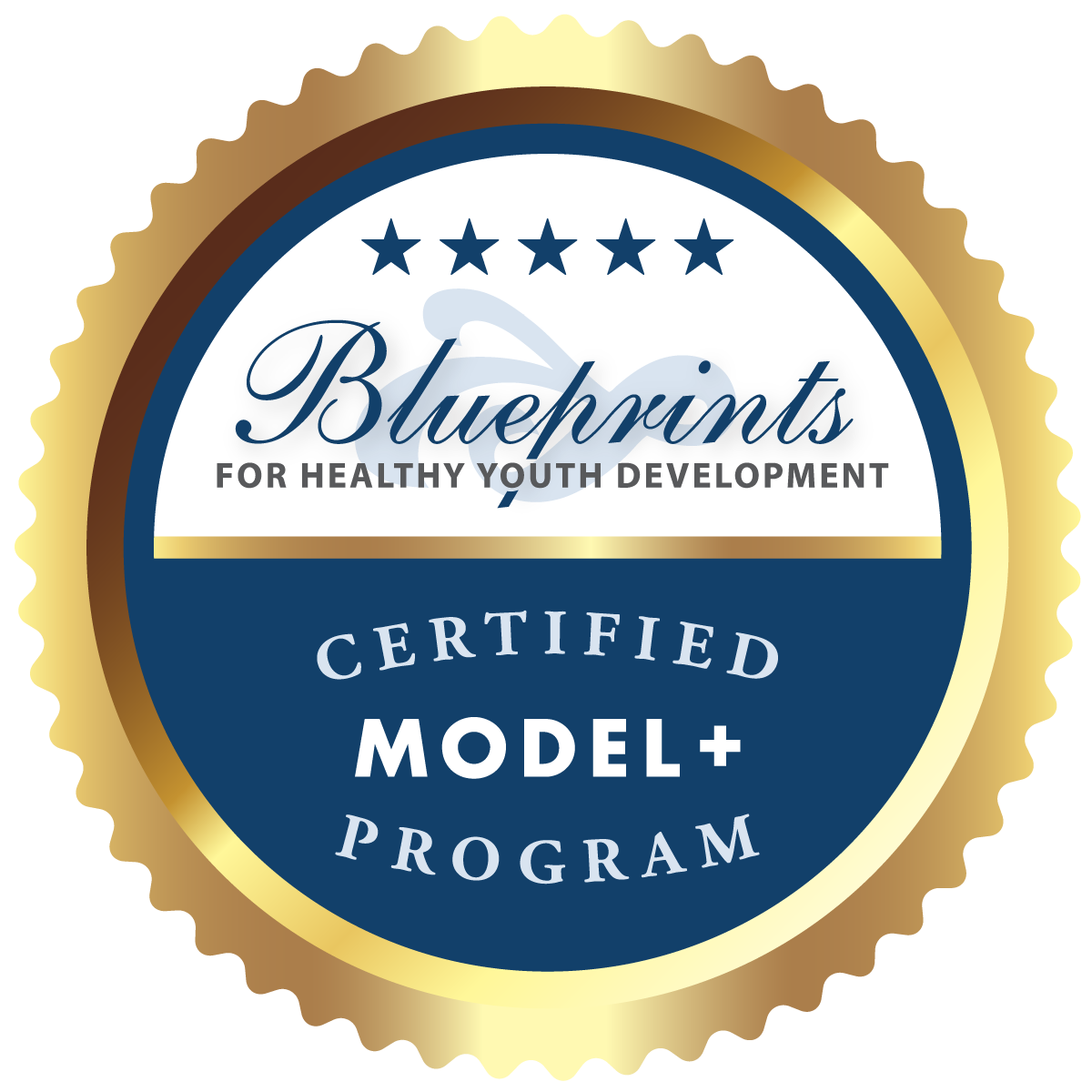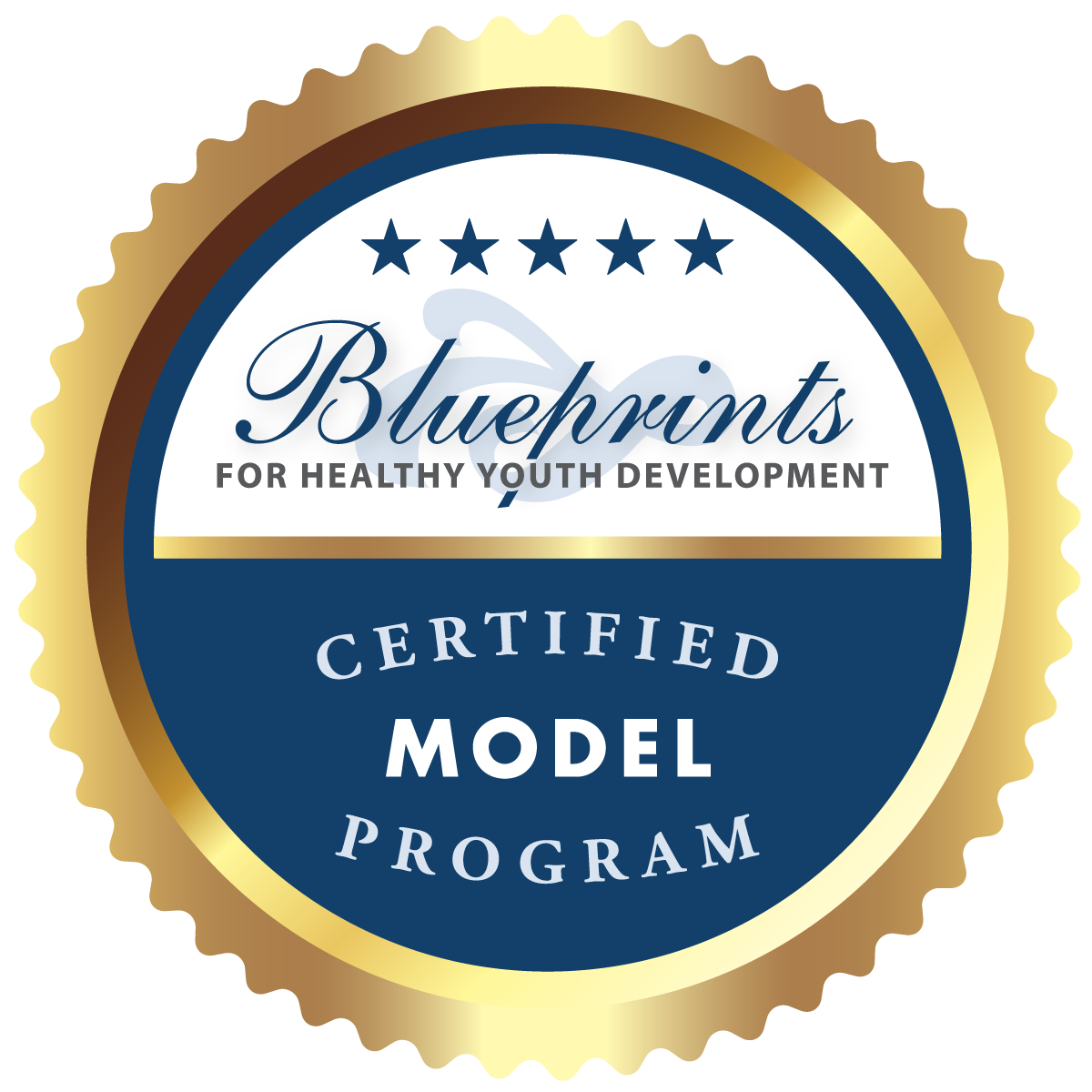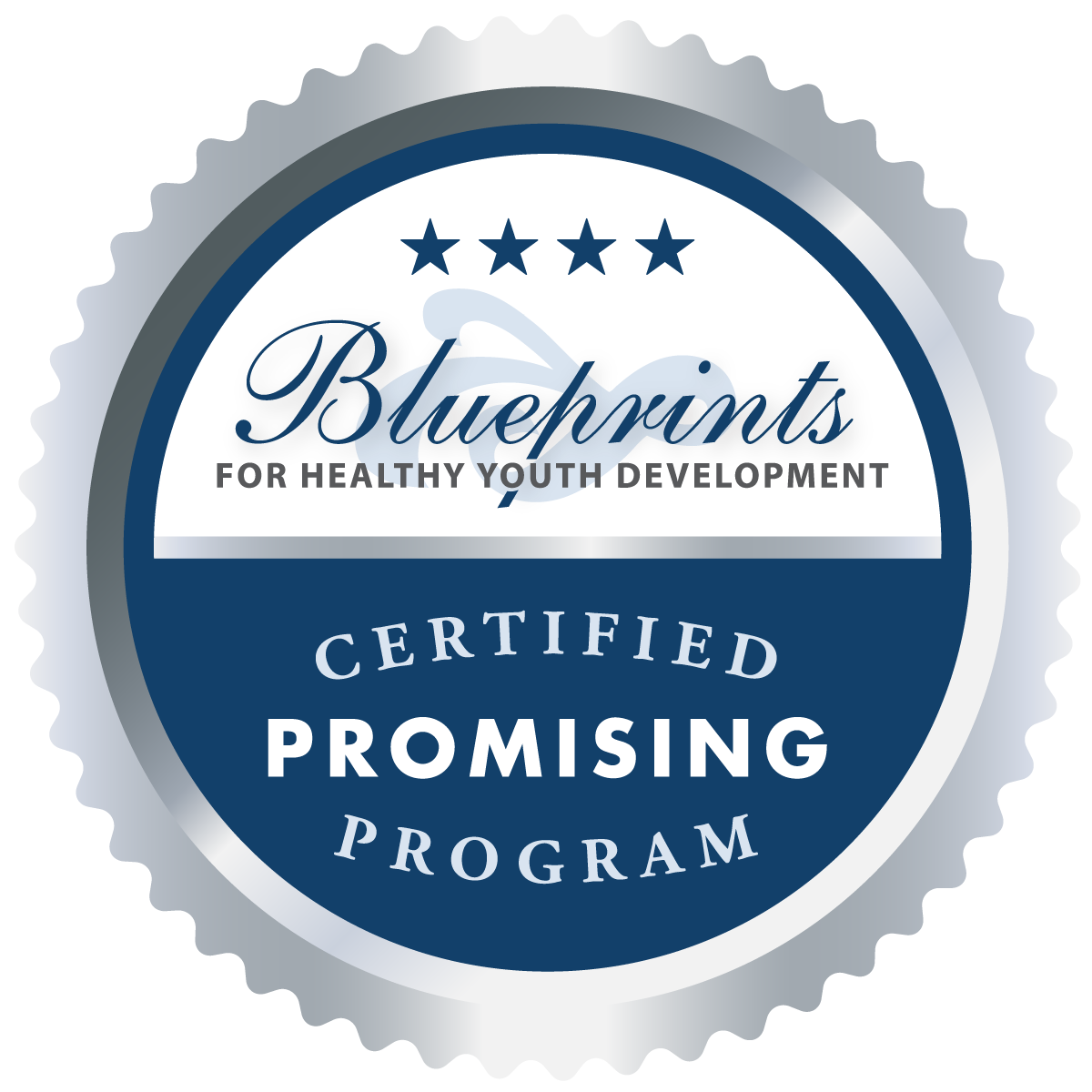
Program Search
This interactive search enables you to identify Blueprints-certified interventions based on specific criteria and then browse through a wide range of interventions that match those criteria. Select only a few criteria of importance, as the number of interventions may be reduced by selecting multiple items ACROSS categories, or increased by selecting multiple items WITHIN categories.
Model and Model Plus programs are listed separately from Promising programs. This is because only Model and Model Plus programs have demonstrated efficacy for changing outcomes over time and are recommended for large-scale implementation. Promising programs show promise of efficacy, but require follow-up research before being recommended for large-scale adoption.
44 Programs
| Program | Rating | Summary |
|---|---|---|
|
GenerationPMTO
|
 Model Plus
Model Plus
|
A family training program that aims to teach effective family management skills in order to reduce antisocial and problematic behavior in children through trainings implemented in a variety of formats and settings.
A family training program that aims to teach effective family management skills in order to reduce antisocial and problematic behavior in children through trainings implemented in a variety of formats and settings.
|
Target Population
Age: Early Childhood (3-4) - Preschool, Late Adolescence (15-18) - High School, Early Adolescence (12-14) - Middle School, Late Childhood (5-11) - K/Elementary |
||
|
LifeSkills Training (LST)
|
 Model Plus
Model Plus
|
A classroom-based substance abuse prevention program designed to prevent teenage drug and alcohol abuse, tobacco use, violence and other risk behaviors by teaching students self-management skills, social skills, and drug awareness and resistance skills.
A classroom-based substance abuse prevention program designed to prevent teenage drug and alcohol abuse, tobacco use, violence and other risk behaviors by teaching students self-management skills, social skills, and drug awareness and resistance skills.
|
Target Population
Age: Early Adolescence (12-14) - Middle School |
||
|
Multisystemic Therapy® (MST®)
|
 Model Plus
Model Plus
|
A juvenile crime prevention program designed to improve the real-world functioning of youth by changing their natural settings - home, school, and neighborhood - in ways that promote prosocial behavior while decreasing antisocial behavior.
A juvenile crime prevention program designed to improve the real-world functioning of youth by changing their natural settings - home, school, and neighborhood - in ways that promote prosocial behavior while decreasing antisocial behavior.
|
Target Population
Age: Late Adolescence (15-18) - High School, Early Adolescence (12-14) - Middle School |
||
|
Multisystemic Therapy - Problem Sexual Behavior (MST-PSB)
|
 Model
Model
|
A juvenile sex offender treatment program designed to reduce criminal and antisocial behavior, especially problem sexual behavior, by providing intensive family therapy services in the youth's natural environment over a 5-7 month period. A juvenile sex offender treatment program designed to reduce criminal and antisocial behavior, especially problem sexual behavior, by providing intensive family therapy services in the youth's natural environment over a 5-7 month period. |
Target Population
Age: Late Adolescence (15-18) - High School, Early Adolescence (12-14) - Middle School |
||
|
Positive Action
|
 Model
Model
|
A school-based social emotional learning program for students in elementary and middle schools to increase positive behavior, reduce negative behavior, and improve social and emotional learning and school climate.
A school-based social emotional learning program for students in elementary and middle schools to increase positive behavior, reduce negative behavior, and improve social and emotional learning and school climate.
|
Target Population
Age: Early Adolescence (12-14) - Middle School, Late Childhood (5-11) - K/Elementary |
||
|
Strong African American Families Program
|
 Model
Model
|
An interactive educational program for African American parents and their early adolescent children living in rural communities that is designed to strengthen family relationships and help adolescents develop positive behaviors and respond effectively to the risks of substance use, delinquency, and sexual involvement. An interactive educational program for African American parents and their early adolescent children living in rural communities that is designed to strengthen family relationships and help adolescents develop positive behaviors and respond effectively to the risks of substance use, delinquency, and sexual involvement. |
Target Population
Age: Early Adolescence (12-14) - Middle School, Late Childhood (5-11) - K/Elementary |
||
|
Treatment Foster Care Oregon
|
 Model
Model
|
A therapeutic foster care program with the goal of reuniting families, reducing delinquency and teen violence, and increasing prosocial behavior and participation in prosocial activities through behavioral parent training and support for foster parents, family therapy for biological parents, skills training and supportive therapy for youth, and school-based behavioral interventions and academic support.
A therapeutic foster care program with the goal of reuniting families, reducing delinquency and teen violence, and increasing prosocial behavior and participation in prosocial activities through behavioral parent training and support for foster parents, family therapy for biological parents, skills training and supportive therapy for youth, and school-based behavioral interventions and academic support.
|
Target Population
Age: Late Adolescence (15-18) - High School, Early Adolescence (12-14) - Middle School |
||
| Program | Rating | Summary |
|---|---|---|
|
A Stop Smoking in Schools Trial (ASSIST)
|
 Promising
Promising
|
A peer support program to reduce the uptake of smoking among young adolescents.
A peer support program to reduce the uptake of smoking among young adolescents.
|
Target Population
Age: Early Adolescence (12-14) - Middle School |
||
|
ABC Project
|
 Promising
Promising
|
An online intervention that aims to reduce hopelessness and strengthen perceived agency in youth with anxiety and depression by teaching them to manage their mood via engagement in valued, enjoyable activities. An online intervention that aims to reduce hopelessness and strengthen perceived agency in youth with anxiety and depression by teaching them to manage their mood via engagement in valued, enjoyable activities. |
Target Population
Age: Late Adolescence (15-18) - High School, Early Adolescence (12-14) - Middle School |
||
|
Achievement Mentoring
|
 Promising
Promising
|
A school-based intervention that aims to reduce drug use and school failure among high-risk adolescents through small group meetings focused on enhancing school attendance, promptness, achievement, and discipline.
A school-based intervention that aims to reduce drug use and school failure among high-risk adolescents through small group meetings focused on enhancing school attendance, promptness, achievement, and discipline.
|
Target Population
Age: Early Adolescence (12-14) - Middle School |
||
|
Adolescent Coping with Depression
|
 Promising
Promising
|
A group depression treatment program that provides teenagers with instruction on ways to manage depression.
A group depression treatment program that provides teenagers with instruction on ways to manage depression.
|
Target Population
Age: Late Adolescence (15-18) - High School, Early Adolescence (12-14) - Middle School |
||
|
ASSISTments
|
 Promising
Promising
|
A school-based program that aims to improve student achievement in mathematics through online homework tools and specialized teacher training. A school-based program that aims to improve student achievement in mathematics through online homework tools and specialized teacher training. |
Target Population
Age: Late Adolescence (15-18) - High School, Early Adolescence (12-14) - Middle School, Late Childhood (5-11) - K/Elementary |
||
|
Be Proud! Be Responsible!
|
 Promising
Promising
|
A multi-session group intervention that aims to reduce risky sexual behavior that leads to potential HIV/STD contraction among adolescents.
A multi-session group intervention that aims to reduce risky sexual behavior that leads to potential HIV/STD contraction among adolescents.
|
Target Population
Age: Late Adolescence (15-18) - High School, Early Adolescence (12-14) - Middle School |
||
|
Big Brothers Big Sisters of America
|
 Promising
Promising
|
A community mentoring program which matches a volunteer adult mentor to a child or adolescent to delay or reduce antisocial behaviors; improve academic success, attitudes and behaviors, peer and family relationships; strengthen self-concept; and provide social and cultural enrichment. A community mentoring program which matches a volunteer adult mentor to a child or adolescent to delay or reduce antisocial behaviors; improve academic success, attitudes and behaviors, peer and family relationships; strengthen self-concept; and provide social and cultural enrichment. |
Target Population
Age: Late Adolescence (15-18) - High School, Early Adolescence (12-14) - Middle School, Late Childhood (5-11) - K/Elementary |
||
|
Bright Bodies Weight Management Program
|
 Promising
Promising
|
A family-based lifestyle intervention that aims to prevent childhood obesity by teaching inner-city kids, teens, and their families about healthy weight management through nutrition education, behavior modification, and exercise.
A family-based lifestyle intervention that aims to prevent childhood obesity by teaching inner-city kids, teens, and their families about healthy weight management through nutrition education, behavior modification, and exercise.
|
Target Population
Age: Late Adolescence (15-18) - High School, Early Adolescence (12-14) - Middle School, Late Childhood (5-11) - K/Elementary |
||
|
Children of Divorce - Coping with Divorce (CoD-CoD)
|
 Promising
Promising
|
An online coping skills program designed to prevent short-term mental health problems among children and adolescents from separated or divorced families. An online coping skills program designed to prevent short-term mental health problems among children and adolescents from separated or divorced families. |
Target Population
Age: Late Adolescence (15-18) - High School, Early Adolescence (12-14) - Middle School |
||
|
Cognitive Behavioral Intervention for Trauma in Schools (CBITS)
|
 Promising
Promising
|
A multi-session group intervention that aims to reduce children's post-traumatic stress disorder (PTSD) symptoms, as well as anxiety and depression resulting from exposure to violence, through child, parent, and teacher educational sessions.
A multi-session group intervention that aims to reduce children's post-traumatic stress disorder (PTSD) symptoms, as well as anxiety and depression resulting from exposure to violence, through child, parent, and teacher educational sessions.
|
Target Population
Age: Early Adolescence (12-14) - Middle School, Late Childhood (5-11) - K/Elementary |
||
|
Communities That Care
|
 Promising
Promising
|
A prevention system designed to reduce levels of adolescent delinquency and substance use through the selection and use of effective preventative interventions tailored to a community's specific profile of risk and protection.
A prevention system designed to reduce levels of adolescent delinquency and substance use through the selection and use of effective preventative interventions tailored to a community's specific profile of risk and protection.
|
Target Population
Age: Early Childhood (3-4) - Preschool, Infant (0-2), Early Adulthood (19-24), Late Adolescence (15-18) - High School, Early Adolescence (12-14) - Middle School, Late Childhood (5-11) - K/Elementary |
||
|
Cooperative Learning
|
 Promising
Promising
|
A school-based intervention designed to provide youth with positive peer relationships that can promote positive behaviors, prevent bullying and victimization, and reduce emotional (mental health) problems and risky behaviors such as alcohol use. A school-based intervention designed to provide youth with positive peer relationships that can promote positive behaviors, prevent bullying and victimization, and reduce emotional (mental health) problems and risky behaviors such as alcohol use. |
Target Population
Age: Early Adolescence (12-14) - Middle School |
||
|
EFFEKT
|
 Promising
Promising
|
An alcohol prevention program designed to reduce teenage alcohol use through parent training.
An alcohol prevention program designed to reduce teenage alcohol use through parent training.
|
Target Population
Age: Early Adolescence (12-14) - Middle School |
||
|
EveryDay Intervention
|
 Promising
Promising
|
A parental information program aimed at improving student attendance in elementary, middle, and high school by targeting parental misconceptions about the importance of regular attendance through mail-based communications.
A parental information program aimed at improving student attendance in elementary, middle, and high school by targeting parental misconceptions about the importance of regular attendance through mail-based communications.
|
Target Population
Age: Late Adolescence (15-18) - High School, Early Adolescence (12-14) - Middle School, Late Childhood (5-11) - K/Elementary |
||
|
Familias Unidas
|
 Promising
Promising
|
A family-based intervention to empower Hispanic immigrant parents to build a strong parent-support network and help their adolescent children respond effectively to the risks of substance use and unsafe sexual behavior. A family-based intervention to empower Hispanic immigrant parents to build a strong parent-support network and help their adolescent children respond effectively to the risks of substance use and unsafe sexual behavior. |
Target Population
Age: Late Adolescence (15-18) - High School, Early Adolescence (12-14) - Middle School |
||
|
Functional Family Therapy (FFT)
|
 Promising
Promising
|
An intensive, short-term family therapy intervention and juvenile diversion program that offers in-home family counseling designed specifically to address the referring behaviors (i.e., curfew violations, running away, and truancy) and juvenile delinquency from a relational, family-based perspective. An intensive, short-term family therapy intervention and juvenile diversion program that offers in-home family counseling designed specifically to address the referring behaviors (i.e., curfew violations, running away, and truancy) and juvenile delinquency from a relational, family-based perspective. |
Target Population
Age: Late Adolescence (15-18) - High School, Early Adolescence (12-14) - Middle School |
||
|
Group Teen Triple P - Level 4
|
 Promising
Promising
|
A group parent training program designed to improve parenting skills, manage family problems, and enhance positive family relationships, ultimately to prevent problem behavior among youth.
A group parent training program designed to improve parenting skills, manage family problems, and enhance positive family relationships, ultimately to prevent problem behavior among youth.
|
Target Population
Age: Early Adolescence (12-14) - Middle School |
||
|
Guiding Good Choices
|
 Promising
Promising
|
A family competency training program that aims to enhance parenting behaviors and skills, to enhance effective child management behaviors and parent-child interactions and bonding, to teach children skills to resist peer influence, and to reduce adolescent problem behaviors.
A family competency training program that aims to enhance parenting behaviors and skills, to enhance effective child management behaviors and parent-child interactions and bonding, to teach children skills to resist peer influence, and to reduce adolescent problem behaviors.
|
Target Population
Age: Early Adolescence (12-14) - Middle School |
||
|
Interpersonal Psychotherapy - Adolescent Skills Training
|
 Promising
Promising
|
An 8-week in-school program designed to reduce and prevent depressive symptoms in adolescents by improving communication skills and interpersonal relationships.
An 8-week in-school program designed to reduce and prevent depressive symptoms in adolescents by improving communication skills and interpersonal relationships.
|
Target Population
Age: Late Adolescence (15-18) - High School, Early Adolescence (12-14) - Middle School |
||
|
KEEP SAFE
|
 Promising
Promising
|
A six-session group-based intervention, facilitated by paraprofessionals, for youth in foster care as they transition to middle school. The program aims to prevent internalizing and externalizing problems that may lead to more serious longer term outcomes such as delinquency, substance use, and high-risk sexual behavior. Foster parents also attend a six-session program.
A six-session group-based intervention, facilitated by paraprofessionals, for youth in foster care as they transition to middle school. The program aims to prevent internalizing and externalizing problems that may lead to more serious longer term outcomes such as delinquency, substance use, and high-risk sexual behavior. Foster parents also attend a six-session program.
|
Target Population
Age: Early Adolescence (12-14) - Middle School |
||
|
Learning Together
|
 Promising
Promising
|
A whole-school program that aims to improve the school environment to reduce bullying and aggression, and promote student health and wellbeing. A whole-school program that aims to improve the school environment to reduce bullying and aggression, and promote student health and wellbeing. |
Target Population
Age: Early Adolescence (12-14) - Middle School |
||
|
New Beginnings (for children of divorce)
|
 Promising
Promising
|
A group-based intervention for divorced parents to promote resilience in children after parental divorce. A group-based intervention for divorced parents to promote resilience in children after parental divorce. |
Target Population
Age: Late Adolescence (15-18) - High School, Early Adolescence (12-14) - Middle School, Late Childhood (5-11) - K/Elementary |
||
|
Olweus Bullying Prevention Program
|
 Promising
Promising
|
A multi-level bullying prevention program designed to reduce and prevent school bullying in elementary, middle, and high schools.
A multi-level bullying prevention program designed to reduce and prevent school bullying in elementary, middle, and high schools.
|
Target Population
Age: Late Adolescence (15-18) - High School, Early Adolescence (12-14) - Middle School, Late Childhood (5-11) - K/Elementary |
||
|
Pace Center for Girls
|
 Promising
Promising
|
A set of gender-responsive prevention and early intervention programs and services culturally grounded for girls with multiple risk factors for juvenile justice system involvement, which uses a holistic approach to re-engage girls with learning, improve academic performance, and address the underlying trauma that contributes to female delinquency. A set of gender-responsive prevention and early intervention programs and services culturally grounded for girls with multiple risk factors for juvenile justice system involvement, which uses a holistic approach to re-engage girls with learning, improve academic performance, and address the underlying trauma that contributes to female delinquency. |
Target Population
Age: Late Adolescence (15-18) - High School, Early Adolescence (12-14) - Middle School |
||
|
Peer Assisted Learning Strategies (PALS)
|
 Promising
Promising
|
A class-wide peer tutoring program for elementary school students to improve reading and mathematics skills of students through guided peer-assisted learning strategies.
A class-wide peer tutoring program for elementary school students to improve reading and mathematics skills of students through guided peer-assisted learning strategies.
|
Target Population
Age: Early Adolescence (12-14) - Middle School, Late Childhood (5-11) - K/Elementary |
||
|
Planet Health
|
 Promising
Promising
|
A two-year school-based health behavior intervention designed to reduce obesity among students in grades 6-8 by increasing energy expenditure while promoting key dietary behaviors.
A two-year school-based health behavior intervention designed to reduce obesity among students in grades 6-8 by increasing energy expenditure while promoting key dietary behaviors.
|
Target Population
Age: Early Adolescence (12-14) - Middle School |
||
|
Power Through Choices
|
 Promising
Promising
|
A sexual health curriculum that aims to improve knowledge and psychosocial outcomes regarding HIV and STIs and thereby reduce rates of sexual activity, STIs, and pregnancy among youth residing in group homes. A sexual health curriculum that aims to improve knowledge and psychosocial outcomes regarding HIV and STIs and thereby reduce rates of sexual activity, STIs, and pregnancy among youth residing in group homes. |
Target Population
Age: Late Adolescence (15-18) - High School, Early Adolescence (12-14) - Middle School |
||
|
Project Personality
|
 Promising
Promising
|
A computer-based intervention that aims to reduce detrimental internalizing behaviors in youth with anxiety and depression by teaching them that personality traits are malleable and improving their perceived behavioral and emotional control. A computer-based intervention that aims to reduce detrimental internalizing behaviors in youth with anxiety and depression by teaching them that personality traits are malleable and improving their perceived behavioral and emotional control. |
Target Population
Age: Late Adolescence (15-18) - High School, Early Adolescence (12-14) - Middle School |
||
|
Promoting Health Among Teens! (Abstinence Only)
|
 Promising
Promising
|
An 8-hour abstinence-based education program to reduce risky sexual behavior for African American youth by providing information on sexual risks and helping teens build negotiation, refusal, and problem solving skills for practicing abstinence.
An 8-hour abstinence-based education program to reduce risky sexual behavior for African American youth by providing information on sexual risks and helping teens build negotiation, refusal, and problem solving skills for practicing abstinence.
|
Target Population
Age: Early Adolescence (12-14) - Middle School |
||
|
Promoting Health Among Teens! (Comprehensive)
|
 Promising
Promising
|
A 12-hour pregnancy prevention program to reduce risky sexual behavior for African American teens through various types of sex education, including HIV/sexually transmitted infections (STI) and pregnancy prevention, safer sex, and abstinence education.
A 12-hour pregnancy prevention program to reduce risky sexual behavior for African American teens through various types of sex education, including HIV/sexually transmitted infections (STI) and pregnancy prevention, safer sex, and abstinence education.
|
Target Population
Age: Early Adolescence (12-14) - Middle School |
||
|
PROSPER
|
 Promising
Promising
|
A delivery system that attempts to foster implementation of evidence-based youth and family interventions, complete with ongoing needs assessments, monitoring of implementation quality and partnership functions, and evaluation of intervention outcomes.
A delivery system that attempts to foster implementation of evidence-based youth and family interventions, complete with ongoing needs assessments, monitoring of implementation quality and partnership functions, and evaluation of intervention outcomes.
|
Target Population
Age: Early Adolescence (12-14) - Middle School |
||
|
Raising Healthy Children
|
 Promising
Promising
|
A preventive intervention with teacher, parent, and child components, designed to promote positive youth development by enhancing protective factors, reducing identified risk factors, and preventing problem behaviors and academic failure.
A preventive intervention with teacher, parent, and child components, designed to promote positive youth development by enhancing protective factors, reducing identified risk factors, and preventing problem behaviors and academic failure.
|
Target Population
Age: Late Adolescence (15-18) - High School, Early Adolescence (12-14) - Middle School, Late Childhood (5-11) - K/Elementary |
||
|
RealTeen
|
 Promising
Promising
|
An internet-based, gender-specific drug abuse prevention program intended to reduce substance use among early adolescent girls through improving personal, social, and drug refusal skills. An internet-based, gender-specific drug abuse prevention program intended to reduce substance use among early adolescent girls through improving personal, social, and drug refusal skills. |
Target Population
Age: Early Adolescence (12-14) - Middle School |
||
|
Reducing The Risk
|
 Promising
Promising
|
A 16-session curriculum to reduce risky sexual behavior by teaching adolescents about reproductive anatomy, risk behaviors and consequences, abstinence, and the use of condoms and birth control to prevent HIV, sexually transmitted infections (STIs), and pregnancy.
A 16-session curriculum to reduce risky sexual behavior by teaching adolescents about reproductive anatomy, risk behaviors and consequences, abstinence, and the use of condoms and birth control to prevent HIV, sexually transmitted infections (STIs), and pregnancy.
|
Target Population
Age: Early Adulthood (19-24), Late Adolescence (15-18) - High School, Early Adolescence (12-14) - Middle School |
||
|
Safe Dates
|
 Promising
Promising
|
A ten-session dating abuse prevention program to raise students' awareness of what constitutes healthy and abusive dating relationships, as well as the causes and consequences of dating abuse.
A ten-session dating abuse prevention program to raise students' awareness of what constitutes healthy and abusive dating relationships, as well as the causes and consequences of dating abuse.
|
Target Population
Age: Early Adolescence (12-14) - Middle School |
||
|
Strengthening Families 10-14
|
 Promising
Promising
|
A group parenting and youth skills program that aims to promote good parenting skills and positive family relationships; reduce aggressive, hostile behavior, and substance abuse in adolescence; and improve family relationships through weekly parent effectiveness training and child skills-building, followed by a family session.
A group parenting and youth skills program that aims to promote good parenting skills and positive family relationships; reduce aggressive, hostile behavior, and substance abuse in adolescence; and improve family relationships through weekly parent effectiveness training and child skills-building, followed by a family session.
|
Target Population
Age: Early Adolescence (12-14) - Middle School, Late Childhood (5-11) - K/Elementary |
||
|
Wyman's Teen Outreach Program
|
 Promising
Promising
|
A nine month program that engages high school students in a minimum of 20 hours of community service learning annually with weekly meetings. The goal is to reduce rates of teen pregnancy, course failure, and academic suspension.
A nine month program that engages high school students in a minimum of 20 hours of community service learning annually with weekly meetings. The goal is to reduce rates of teen pregnancy, course failure, and academic suspension.
|
Target Population
Age: Late Adolescence (15-18) - High School, Early Adolescence (12-14) - Middle School |
||
 Program
Program